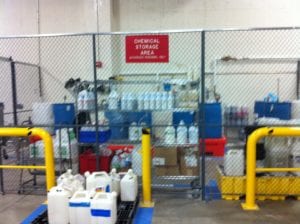Outsourcing environmental compliance reports
Do you wear a lot of hats at your company? Do production problems, equipment maintenance, personnel issues and countless other urgent and important issues take up all your time? Does environmental compliance reporting get pushed to the back burner – sometimes too far back?
You are not alone. This problem happens to almost every company. Environmental compliance issues are not their number one priority. Filling out environmental compliance reports does nothing to help get product out the door. Regulations keep changing, even the forms keep changing. Who has time to keep up?
Here at Ambipar Response EMS, regulations are what we do. Since we work with environmental compliance issues every day, we are very good at it–and very efficient, too.
This article summarizes seven common types of environmental compliance reports required by state or federal environmental agencies. These are only general requirements and certainly nowhere near a complete list of reports that may be required of a particular facility.
 1. Air Emissions Reporting
1. Air Emissions Reporting
An annual Emission Statement is required from all facilities that emit or have the potential to emit certain air contaminants over specific thresholds.
EPA requires that states collect data, establish certain thresholds, at least as stringent as EPA’s, and states in turn require reports from industry. Most states require online submittal of information, but some allow paper submittals. States also utilize the reports to impose an emissions fee for “regulated pollutants” and/or determine if control technologies are required.
2. Annual and Semi-Annual Air Monitoring and Compliance Certifications
If you do not have a Title V operating permit, you do not have to worry about this one! However, if your facility is subject to National Emission Standards for Hazardous Air Pollutants (NESHAP), also known as “MACT” standards, or New Source Performance Standards (NSPS), you may be required to submit periodic monitoring reports and compliance certifications typically due on an annual or semi-annual basis or even more frequently as required by your Title V operating permit.
3. Hazardous Waste Reporting
Federal regulations require large quantity generators to submit a report, every two years, regarding the nature, quantities and disposition of hazardous waste generated at their facility. EPA refers to this as the National Biennial RCRA Hazardous Waste Report or Biennial Report.
The Biennial Report form (EPA form 8700-13A/B) must be submitted to the authorized state agency or EPA regional office by March 1 of every even-numbered year (for example, a report due by March 1, 2018, would report activities from calendar year 2017). The form includes information such as:
- Facility’s EPA ID Number,
- Facility’s name and address,
- Quantity and nature of hazardous waste generated, and
- Whether the hazardous waste was sent for recycling, treatment, storage, or disposal.
4. Discharge Monitoring Reporting
A Discharge Monitoring Report (DMR) is a regulatory term for a periodic water pollution report prepared by industries, municipalities and other facilities discharging to surface waters. DMRs contain self-monitoring results for wastewater required by National Pollutant Discharge Elimination System (NPDES) permits and some Water Quality Management (WQM) permits. These reports are completed and submitted periodically to state and other agencies (typically monthly, quarterly, semi-annually or annually). Some states require electronic submittals while other states allow either electronic or paper submittals.
NPDES permits frequently require additional information, i.e., supplemental reports, to be attached to DMRs. Some state use the Federal NPDES permitting system while other states such as NJ (NJDPES) and NY (SPEDES) have their own discharge permitting systems.
5. Stormwater Pollution Prevention Plan Update Certifications
Owners and operators of industrial facilities, which are subject to a State or EPA industrial stormwater general permit, typically must develop a Stormwater Pollution Prevention Plan (SPPP or SWPPP) as a basic requirement. If your facility is subject to such a requirement, failing to develop a SWPPP can result in enforcement action against your facility by either EPA or your State. EPA has targeted enforcement actions against some industrial sectors for failing to have developed SWPPPs.
Annual updates are required for certain facilities as part of a NPDES permit. Each state may have different requirements. Update certifications are typically mailed to the state environmental agency.
6. Community Right to-Know

The Emergency Planning and Community Right-to-Know Act (EPCRA) of 1986 requires industry to report on the storage, use and releases of hazardous substances to federal, state, and local governments.
Submission of a Tier I form provides State and local officials and the public with information on the general hazard types and locations of hazardous chemicals present at your facility during the previous calendar year.
Submission of a Tier II form provides State, local officials, and the public with specific information on potential hazards. This includes the locations, as well as the amount, of hazardous chemicals present at your facility during the previous calendar year. Some states may have specific requirements for reporting and submission of the Tier II inventory form and/or the state reporting form or format.
States have been initiating enforcement efforts targeting industries with certain North American Industry Classification System (NAICS) codes that have not filed reports and did not receive an exemption from filing.
7. Toxic Release Inventory
If a facility meets all three of the criteria below, it must prepare and submit a Toxics Release Inventory (TRI) reporting form (Form A or Form R) for each chemical for which the reporting requirement is triggered:
- Is in a covered industry sector (e.g., manufacturing, mining, electric power generation, etc.) (Click here to learn about TRI-covered industry sectors. Click here to see TRI-covered NAICS codes.)
- Employs 10 or more full-time equivalent employees (Click here to learn about the employment threshold.)
- Manufactures, processes, or otherwise uses a TRI-listed chemical in the quantities above threshold levels in a given year. (Click here to learn about chemical activity thresholds. Click here to view covered individual chemicals and associated threshold levels. Click here to view covered chemical categories.)
Environmental Compliance – EPA Penalties
The financial penalties for non-compliance can be harsh and the bad publicity can last a long time. Since compliance failures and fines are published on the internet, bad publicity lasts forever. So, if you want to do business, and have a reputation as being a good corporate citizen, environmental compliance is a necessary evil.
There are many, many different environmental regulations. Regulations that may specifically apply to your business depending upon such things as the type and amount of materials you use, your processes, your waste products, your industry and even where your facility is located. Every state has different regulations and even separate locations within a state may have different regulations. Where states have similar reporting requirements, they may have different report due dates. Sound confusing? That is because it is!
Focus your efforts on what is important for your business. Outsource environmental compliance to professionals who can do it faster and cheaper than you can. Understanding and complying with environmental regulations, identifying pollution prevention strategies and recognizing energy efficiency opportunities is our job and we are here to help. Contact us at https://emsenv.com/.

